Operator Details
Overview
There are two types of operators - non-speech operators and speech operators (specifically created to work with speech applications). The type of operator is determined by the type of operator group the operator belongs to. If the operator is placed in a non-speech operator group, he will NOT have any speech attributes. On the other hand, if the operator is included in a speech operator group, he will inherit that group's speech attributes (ex: the operator group's speech profile).
The "Operator Details" page focuses on the operator's identification, corresponding access rights and, if the operator is to work with speech applications, the operator's speech profile details. A speech operator includes specific speech settings identified as Comfort Settings. When a speech operator is created within an operator group, these comfort settings are inherited from the operator group's defined speech profile. If you, then, edit/customize the operator's comfort settings, the entered values are maintained, even if a new speech profile is assigned to the operator (in the profile or via the operator group).
Click ![]() (in the Control Panel) and, in the resulting row below, select
(in the Control Panel) and, in the resulting row below, select ![]() to open the "Operators" page.
to open the "Operators" page.
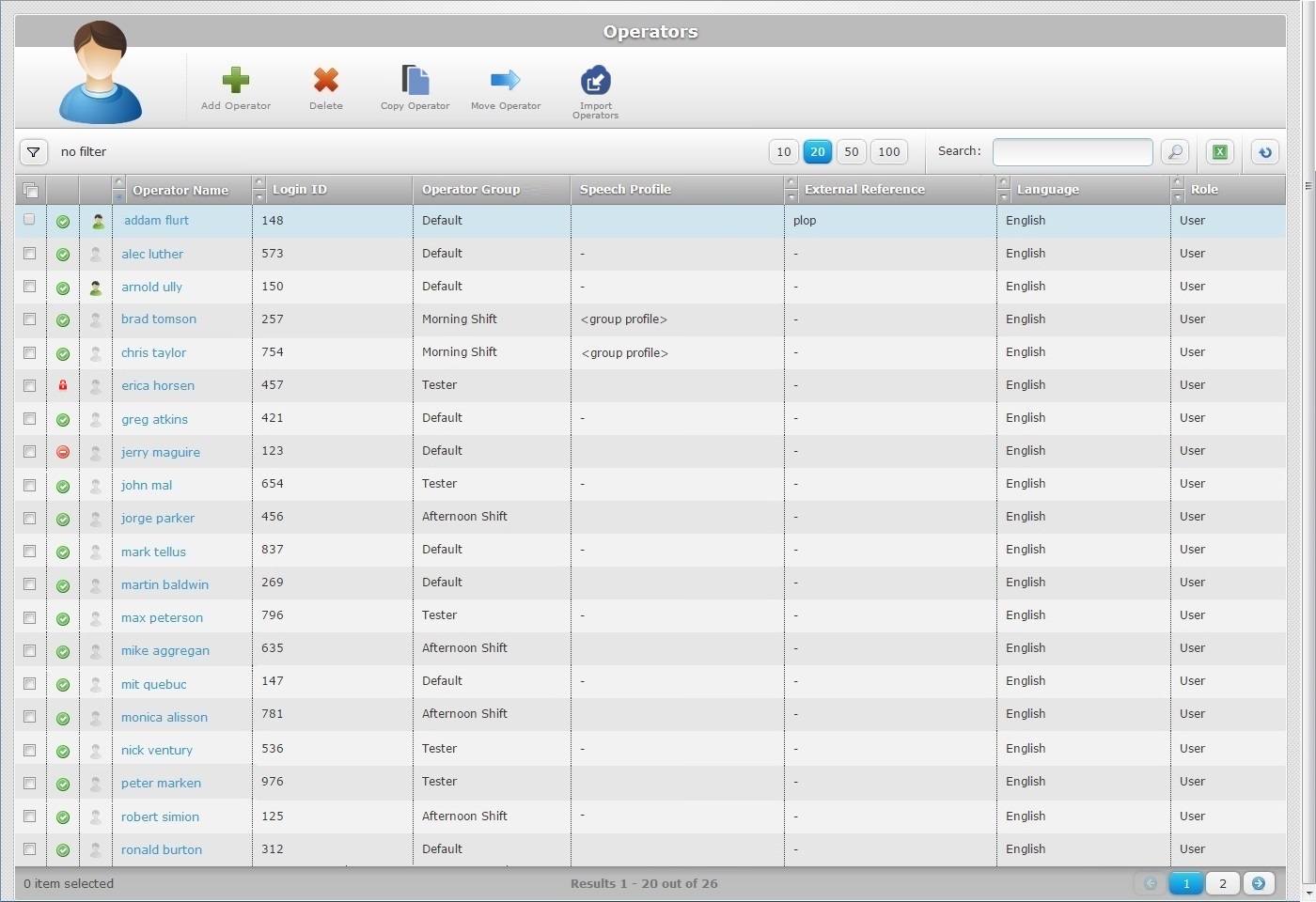
Select the operator you want to view by clicking the operator's name (displayed in light blue). This opens the corresponding "Operator Details" page which includes several tabs (Properties, Info, Devices, Access Rights, and, if the operator is a speech operator, the Speech In, Speech Out and Misc Speech Settings tabs) and a "left panel".
By default, the "Operator Details" page opens in the "Properties" tab.
![]()
The "Operator Details" page offers a visual hint regarding the type of operator you have selected. If it is a speech operator, the operator icon will be different, it will have headsets. The non-speech operator icon is the same as the one displayed in the "Operators" page (without headsets).
The following images/explanations concern a speech operator because the corresponding "Operator Details" page displays all the options included in a non-speech operator profile as well as all the possible speech related options available.
![]() The available information in all the speech related tabs of an "Operator Details" page depends on the selected speech profile (its enabled/disabled parameters and locked/unlocked options).
The available information in all the speech related tabs of an "Operator Details" page depends on the selected speech profile (its enabled/disabled parameters and locked/unlocked options).
Ex: If the "Speech Output" setting of the selected speech profile is disabled, the operator using this profile will not have any information in the "Speech Out" tab of his profile (in the "Operator Details" page).
Even after having assigned a speech profile to an operator/operator group, you can define some of the values included in the speech related tabs, regarded as "comfort settings" (ex: "Recognizer Sensitivity", "TTS Speed", "TTS Volume"). Since they relate to the operator's unique speech characteristics, they will not change even if you apply a different speech profile to the operator/operator group. In other words, regardless of the assigned speech profile (global or local), the operator's speech comfort settings you have defined do NOT change.
Properties tab
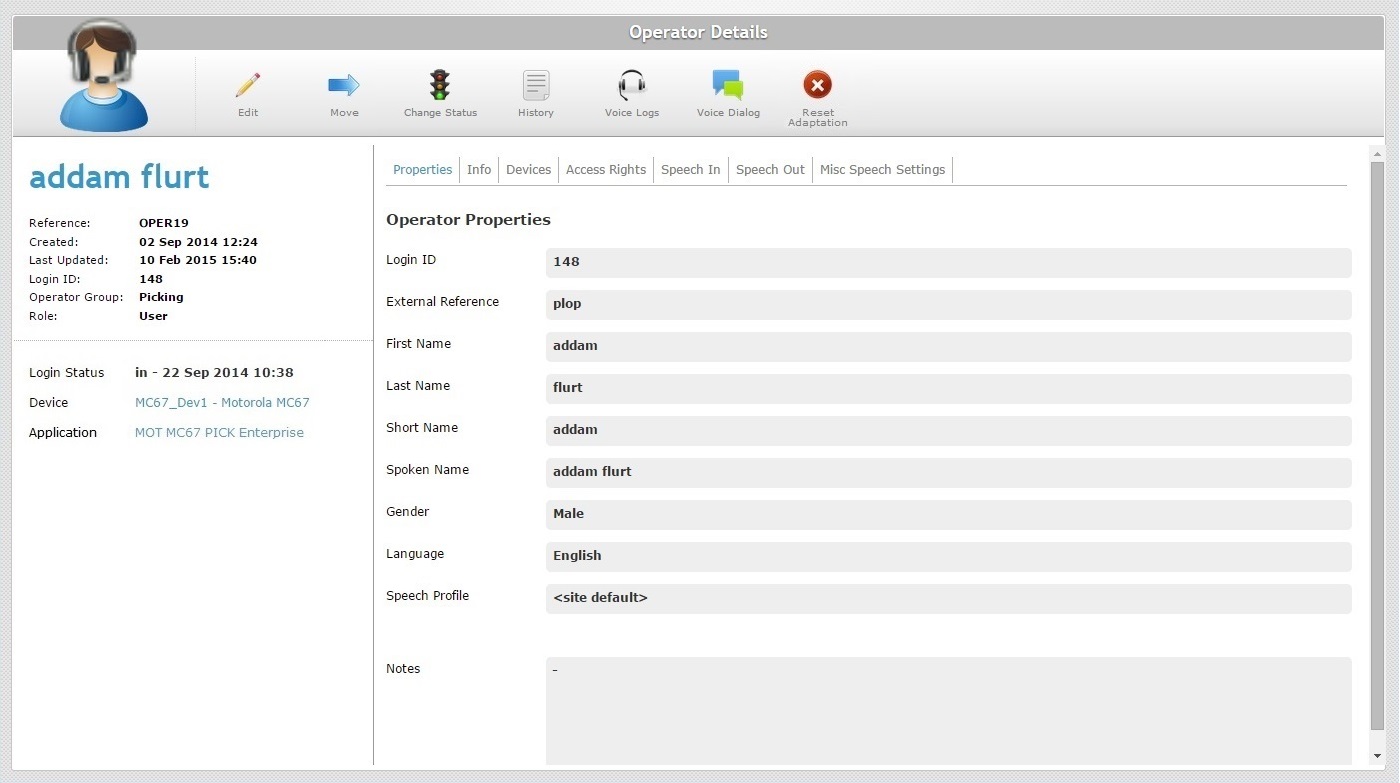
This tab displays the following information:
Login ID |
The operator's identification number in the account. It is also necessary within MCL Operator Login - an optional application provided by MCL installed in the device being used by the operator. |
External Reference |
The operator's identification in the customer's own management software system (ex: ERP or WMS systems). It can also be used in the non-speech version of the MCL Operator Login application. See MCL-Operator Login Application.
|
First Name |
The operator's first name. |
Last Name |
The operator's last name. |
Short Name |
An alternative name to identify the operator. This information is used within MCL Operator Login (an optional application provided by MCL installed in the device being handled by the operator) to identify the logged in operator in App Desktop. |
Spoken Name |
The operator's name that is prompted to the operator in the speech dialog (ex: a welcome message). |
Gender |
The operator's gender. |
Language |
The language used by the operator in the application. |
Speech Profile |
The operator's associated speech profile. This field is only available for speech operators. If the speech profile has been set as an entity's default or custom profile, along with its name, you will view one of the following designations: <group profile> - The operator is associated to the speech profile set as default for the operator group he belongs to. Used in both levels of speech profile management (Global or Local). <account default> - The operator is using the speech profile set as default for the account. Only used within the Global Speech Profile Management. <site default> - The operator is using the speech profile set as default for the current site. Only used within the Local Speech Profile Management. <custom profile> - The operator was attributed a custom speech profile, meaning, a profile created specifically for him. |
Notes |
Free text field that can include information on the operator. |
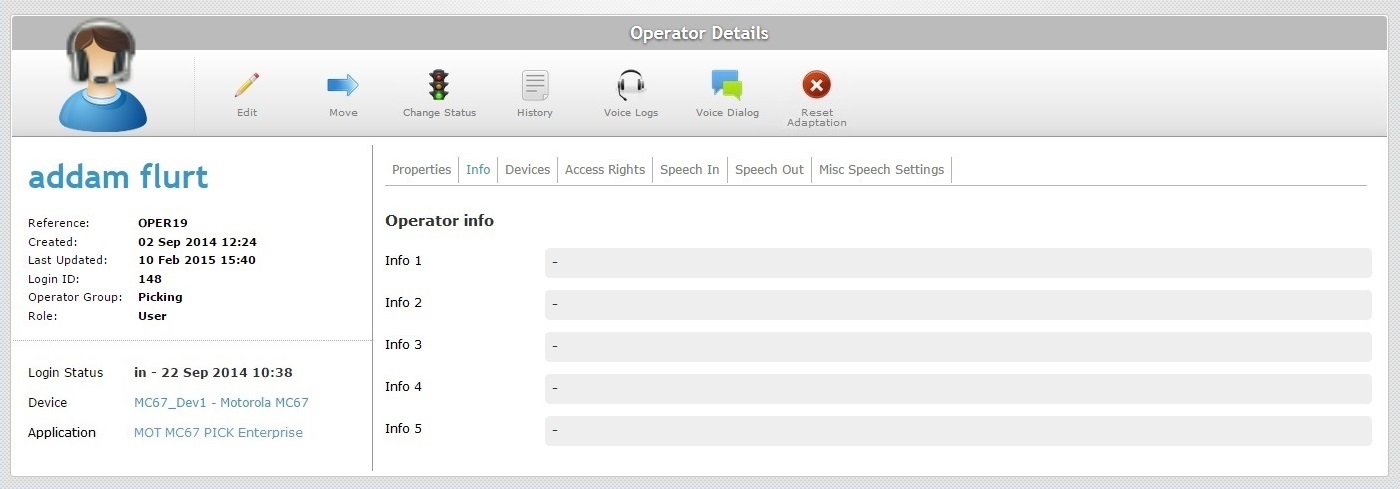
This tab displays the following information:
Info 1 > 5 |
Internal information regarding the operator. The field labels can be customized to display something other than "Info...". See "Editing Site Details" - Custom Labels tab.
When developing an application with MCL-Designer, you can use system variables to link the information you enter in these fields to the application itself. Ex: If you use the X_USR_CUST3 system variable within an MCL Designer developed application, you can retrieve the information entered in this field. |
Devices tab
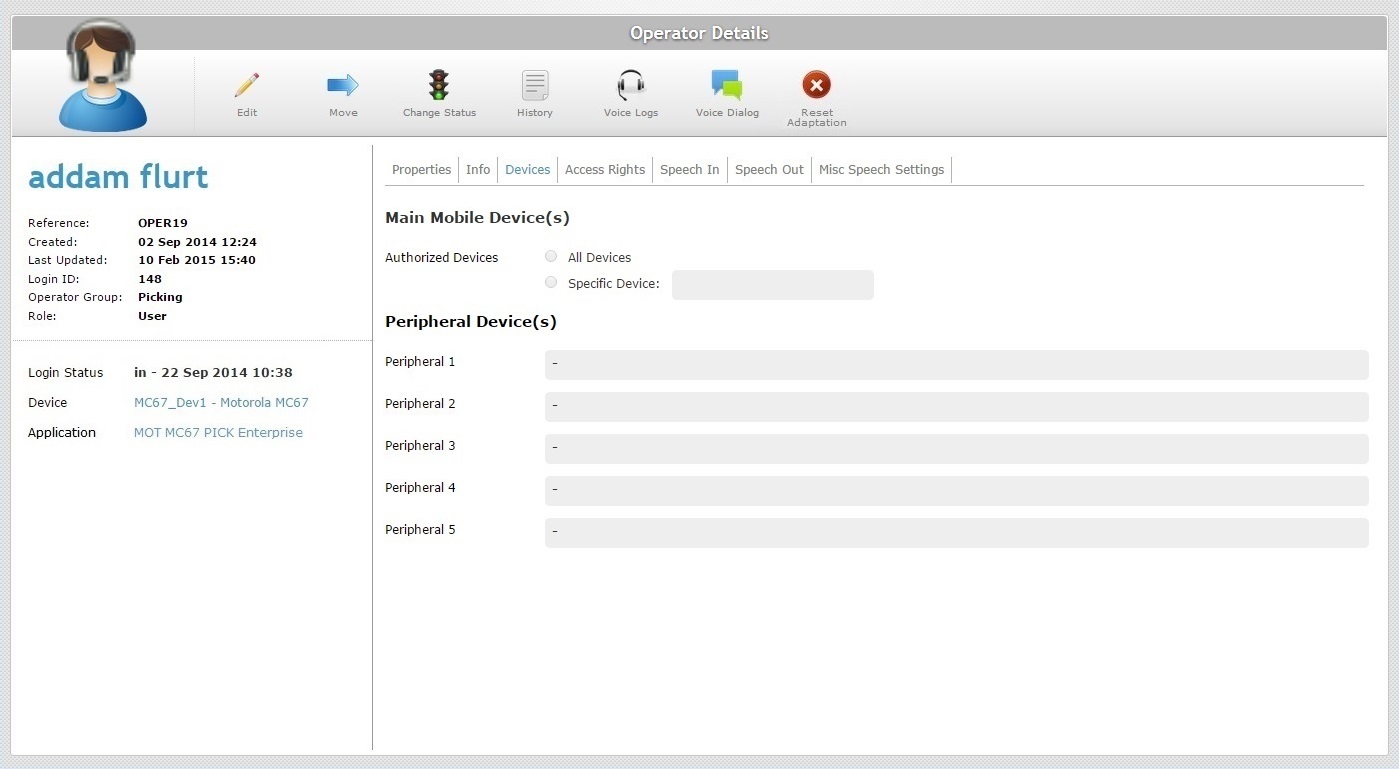
This tab displays the devices available to the operator:
Main Mobile Device(s) |
|
Authorized Devices |
All Devices: If this option is checked, it means that the operator can use all the site's devices. Specific Device: If this option is checked, it means that the operator can only use the device mentioned in the corresponding box. |
Peripheral Device(s) |
|
Peripheral 1 > 5 |
Information regarding peripheral devices being used by the operator. The field labels can be customized to display something other than "Peripheral...". See "Editing Site Details" - Custom Labels tab.
|
Access Rights tab
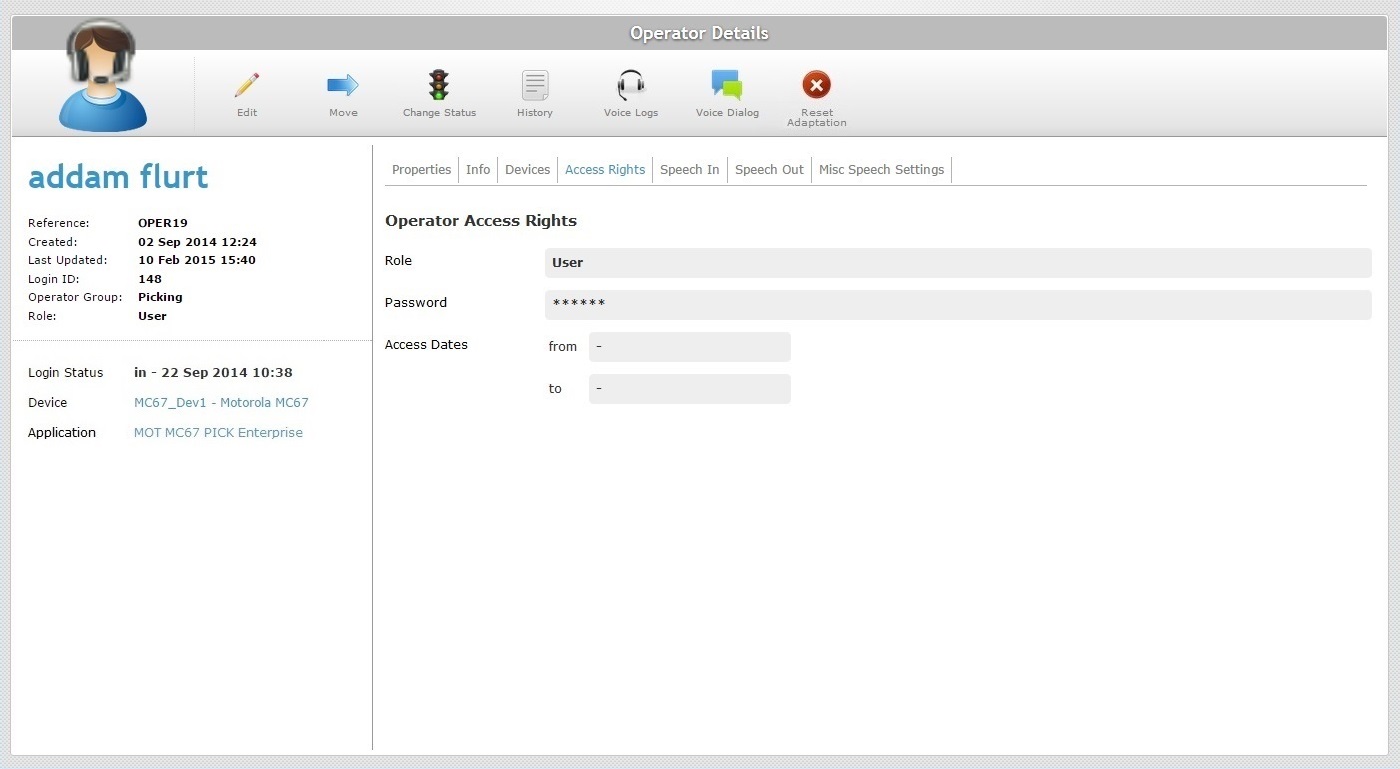
This tab displays the following information:
Role |
The operator's role within the application. |
Password |
The operator's login password to the system. |
Access Dates |
The period of time that the operator is authorized to access the application(s). If this field is not filled, the operator has no access time restrictions. |
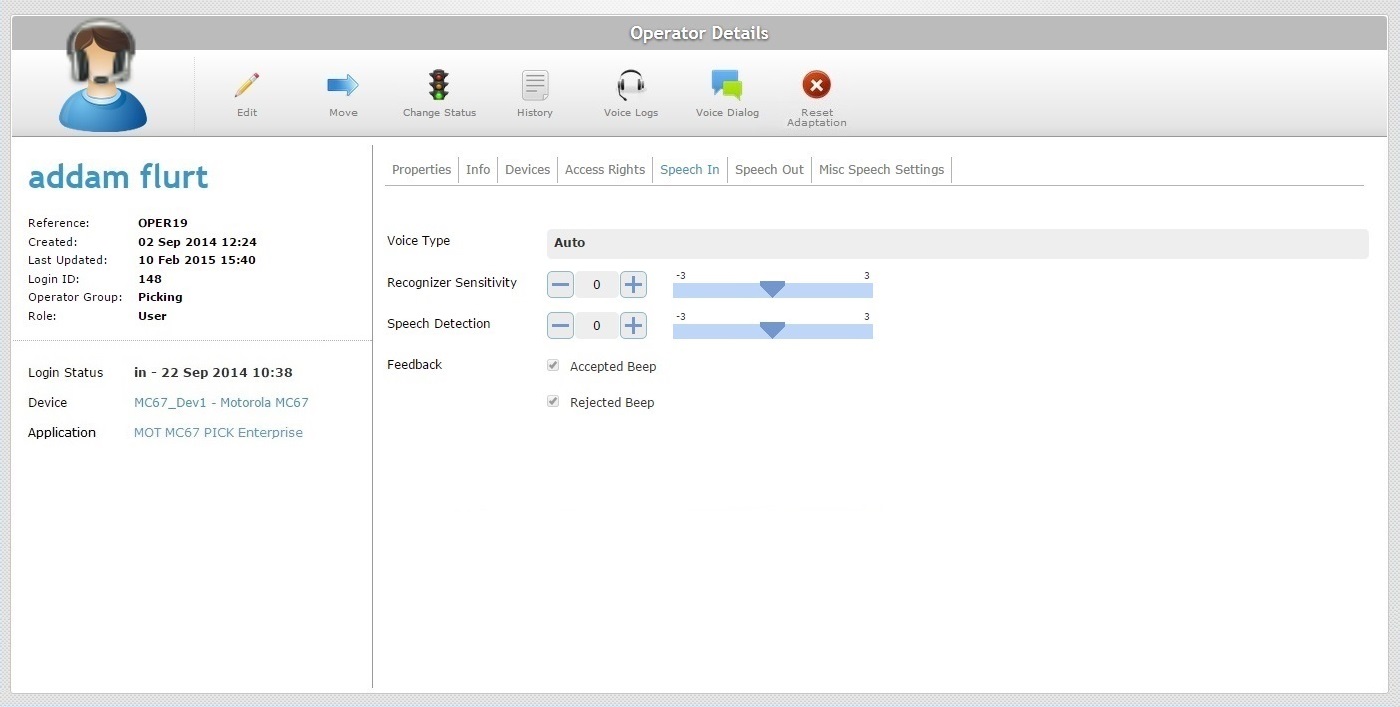
This tab (as well as the "Speech Out" and "Misc Speech Settings" tabs) is only available if the selected operator is a speech operator.
![]() If the speech profile you selected for the operator does not have "Speech Input" enabled, this tab will be blank. If the speech profile includes the Speech Input setting, the tab will display the corresponding values.
If the speech profile you selected for the operator does not have "Speech Input" enabled, this tab will be blank. If the speech profile includes the Speech Input setting, the tab will display the corresponding values.
It displays the following information:
Voice Type |
The available voice types are Auto, Neutral, Male, Female or Child. For most cases, the default value (Auto) is preferable. This parameter is responsible for the filtering of the speech signal spectrum and its purpose is to optimize user speech decoding. When the voice type is set to "Auto", the system executes an adaptation, over time, to match the speech input signal. If you select another voice type (Neutral, Male, Female or Child), this progressive auto adjustment is bypassed, providing better initial performance. Defining the wrong voice type will affect speech recognition quality. This parameter consists of pure front-end audio filtering and has nothing to do with phonemes or recognition algorithms. The fine tuning starts each time the voice profile is loaded into memory. |
||||||||||||||||||
Recognizer Sensitivity |
(** Comfort Setting) This setting is only visible if the speech profile you selected for the operator does not have this option locked OR if you have created a custom speech profile for this operator. Recognizer sensitivity defines the general acceptance balance regarding recognized words. Its purpose is to match the operator's speech to the expected words. (Available values from -3 to +3). When setting the recognizer sensitivity value, you must take the operator's speech level into account: •a good speech -high energy/loud and clear word pronunciation. •a poor speech -low energy and bad word pronunciation. Also, consider the operator's environment and if the resulting background noise level can interfere with word recognition. Ex: Too low recognizer sensitivity dismisses background noise but does NOT accept an operator's "poor" speech.
Possible settings based on general considerations:
Fine tuning suggestions:
|
||||||||||||||||||
Speech Detection |
(Aka Microphone Sensitivity) (** Comfort Setting) This option is only visible if the speech profile you selected for the operator does not have this option locked OR if you have created a custom speech profile for this operator. It defines the "Speech Detection" levels that will "isolate" background noise from actual speech based on the received energy level. (Available values from -3 to +3). A high speech sensitivity helps detect a low energy speech (operator with a soft voice) but it increases the risk of noise processing. A low speech sensitivity reduces the risk of noise processing but requires a high energy speech (operator must speak loud and clear) for a good detection.
For operators with a loud and clear voice, define a speech sensitivity value of -1 or -2.
Note that some words start with low energy (ex: words with an initial "sh" sound) which means they might not be detected if the speech sensitivity value is too low.
|
||||||||||||||||||
Feedback |
Accepted Beep - If it is checked, it means the success beep is enabled. If it is not checked, the success beep is disabled. Rejected Beep - If it is checked, it means the rejection beep is enabled. If it is not checked, the rejection beep is disabled. |
** Comfort Settings - speech settings that relate to each operator's unique speech pattern (ex: "Speech Detection", "Recognizer Sensitivity") and can, therefore, be edited/customized to fit each operator, regardless of the assigned speech profile to the operator group.
When you assign a speech profile to an operator group for the first time, the operators inherit among other things, the values of the comfort settings that were defined in the speech profile. You can maintain those values or you can edit them to fit each operator's speech. Once you edit those comfort settings within an operator's profile, they will no longer be affected by the assignment of other speech profiles. The only way to change those comfort setting values, will be to edit the intended operator profile (in the "Operator Details" page).
To edit Comfort Settings, see Editing Operator Details (the "Speech In" and "Speech Out" tabs).
![]()
If the operator is associated to a "custom" speech profile, additional speech related options are visible. This is due to the fact that there are no inherited parameters from a speech profile, all the speech settings were created in the operator's profile.
A "custom" speech profile is an exception to be used in specific cases because the profile is designed to only suit the operator it is created for.
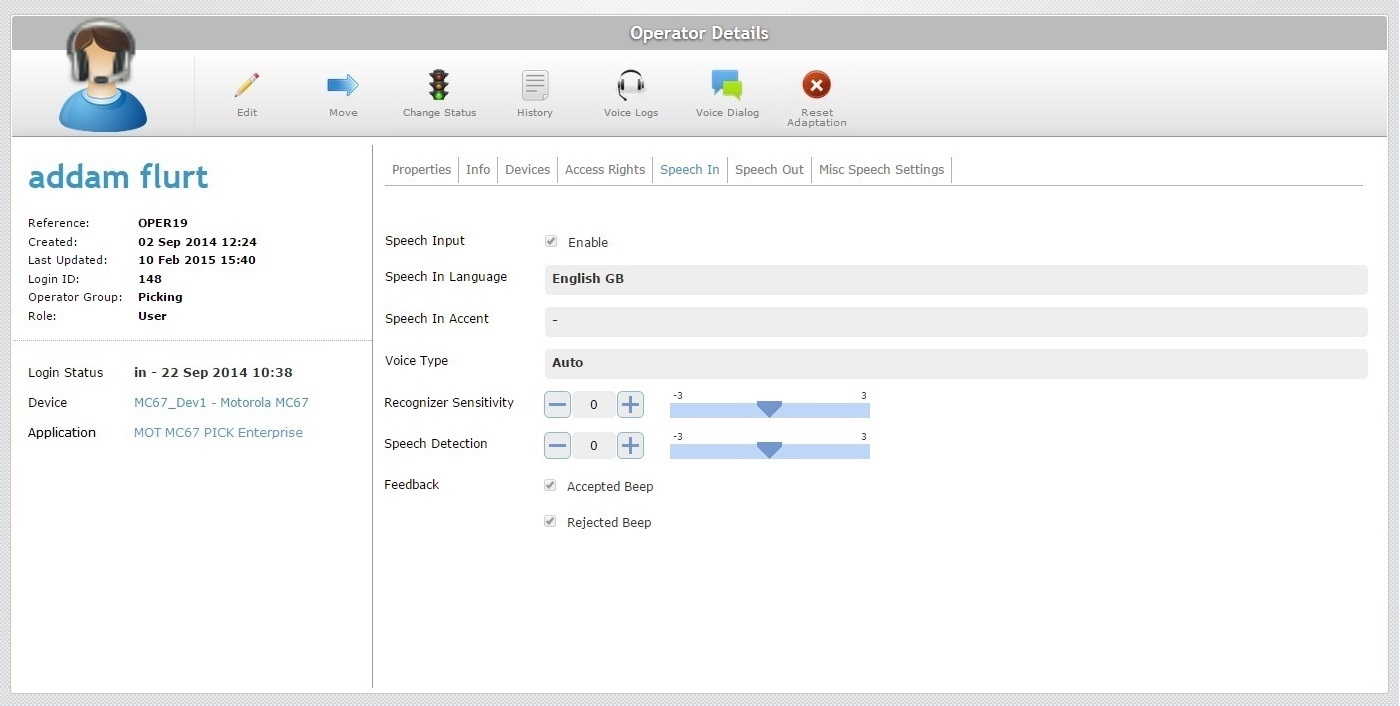
These are the additional options. Check the table above for information on the other options (Voice Type; Recognizer Sensitivity, Speech Detection and Feedback).
Speech Input |
If this option is checked, the custom speech profile enables the use of an input language. This activates options related to input speech parameters. If it is NOT checked, the input language is NOT enabled and all input speech related options are disabled. |
Speech In Language |
The language used by the operator to interact with the speech application (input language). |
Speech In Accent |
The accent file that stores the fine tuning of speech recognition (speech transcriptions for the original spoken word). |
Speech Out tab
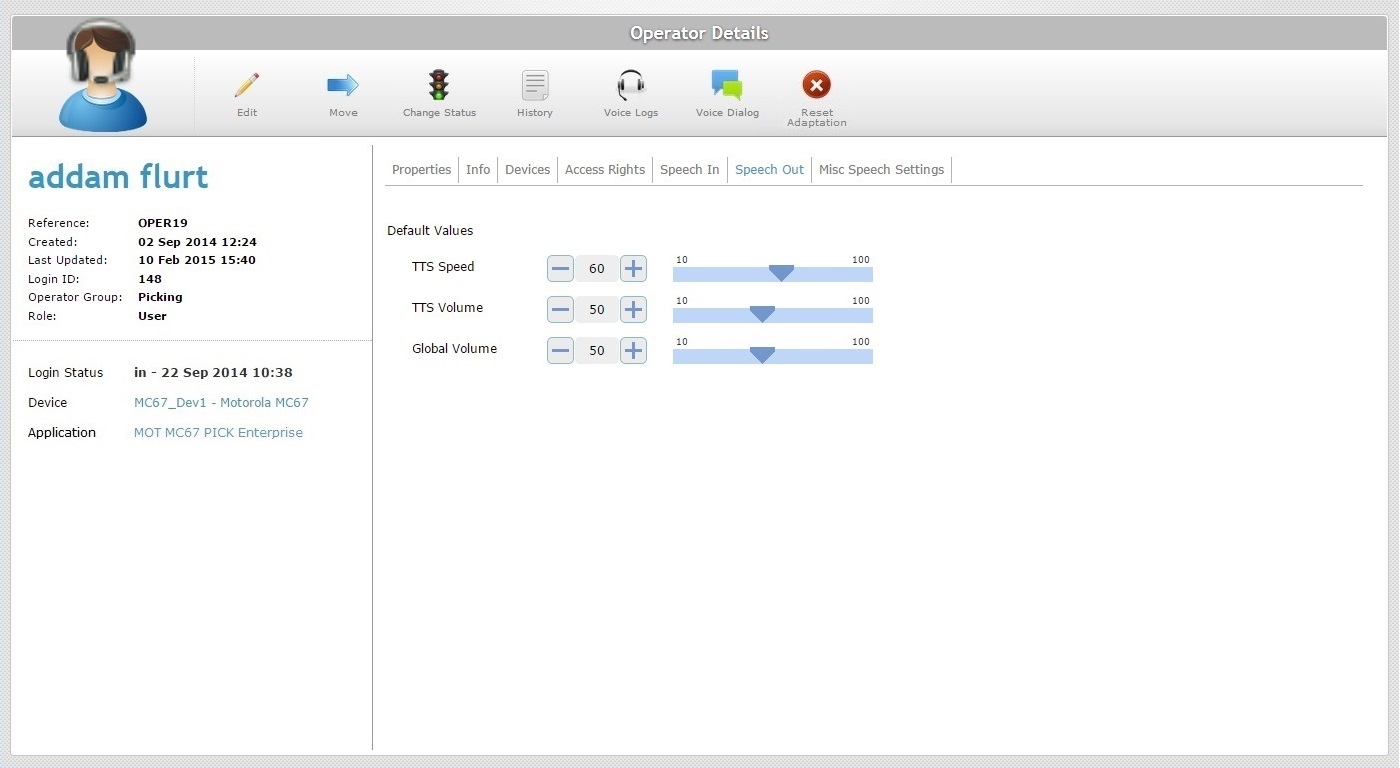
This tab (as well as the "Speech In" and "Misc Speech Settings" tabs) is only available if the selected operator is a speech operator.
![]() If the speech profile you selected for the operator does not have "Speech Output" enabled, this tab will be blank. If the speech profile includes the Speech Output setting, the tab will display the corresponding values.
If the speech profile you selected for the operator does not have "Speech Output" enabled, this tab will be blank. If the speech profile includes the Speech Output setting, the tab will display the corresponding values.
It displays the following information:
Default Values |
|
TTS Speed |
The speed used by the TTS (text to Speech) engine. (** Comfort Setting) |
TTS Volume |
The speech volume used by the TTS (text to Speech) engine. The TTS Volume parameter affects the Synthesizer channel only (TTS). (** Comfort Setting) |
Global Volume |
The global volume sets the volume of all channels (recognition/rejection beep, application beep, TTS, wave player, etc.). (** Comfort Setting) |
** Comfort Settings - speech settings that relate to each operator's unique speech pattern (ex: "TTS Speed", "TTS Volume", "Global Volume) and can, therefore, be edited/customized to fit each operator, regardless of the assigned speech profile to the operator group.
When you assign a speech profile to an operator group for the first time, the operators inherit among other things, the values of the comfort settings that were defined in the speech profile. You can maintain those values or you can edit them to fit each operator's speech. Once you edit those comfort settings within an operator's profile, they will no longer be affected by the assignment of other speech profiles. The only way to change those comfort setting values, will be to edit the intended operator profile (in the "Operator Details" page).
To edit Comfort Settings, see Editing Operator Details (the "Speech In" and "Speech Out" tabs).
![]()
If the operator is associated to a "custom" speech profile, additional speech related options are visible. This is due to the fact that there are no inherited parameters from a speech profile, all the speech settings were created in the operator's profile. A "custom" speech profile is an exception to be used in specific cases because the profile is designed to only suit the operator it is created for.
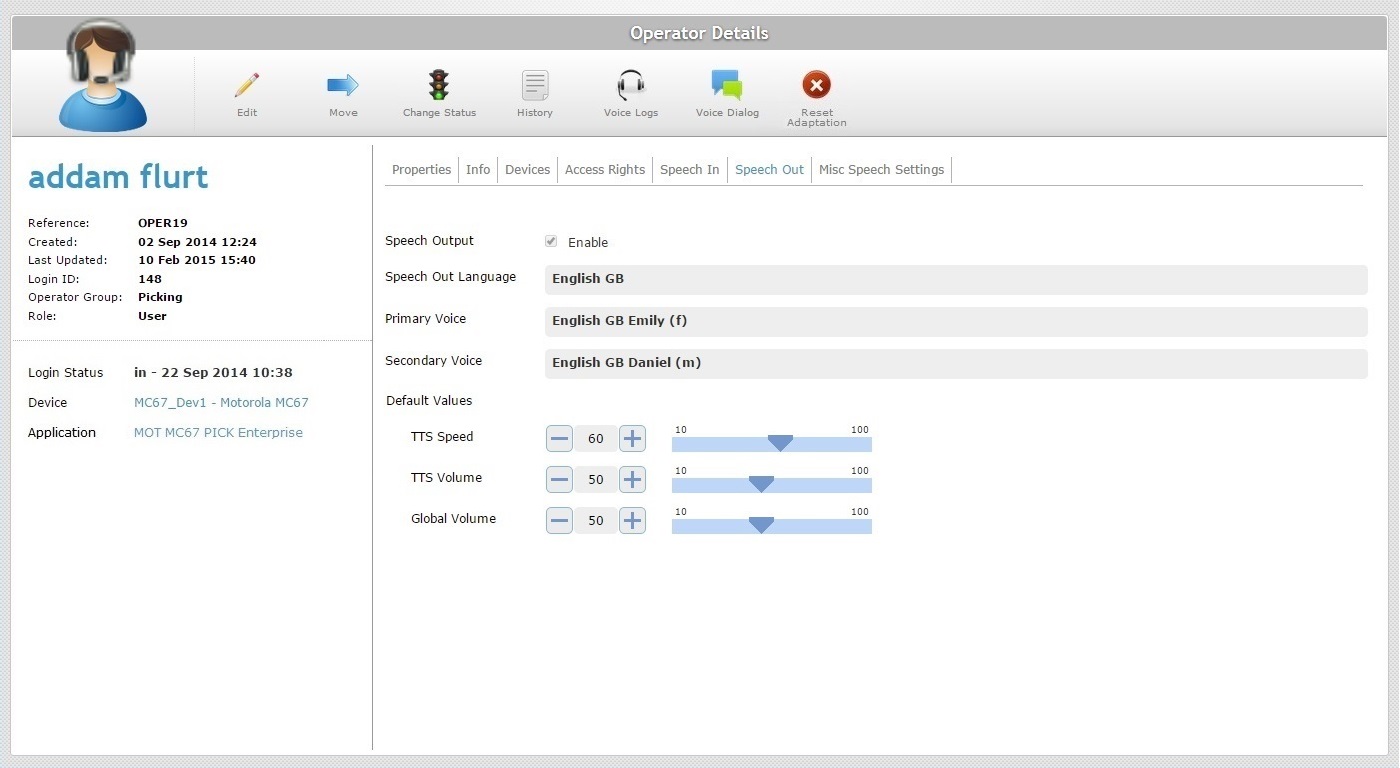
These are the additional options. Check the table above for information on the other options (the Default Values).
Speech Output |
If this option is checked, the custom speech profile enables the use of an output language. This activates options related to output speech parameters. If it is NOT checked, the output language is NOT enabled and all output speech related options are disabled. |
Speech Out Language |
The language the operator will hear from the device (output language). |
Primary Voice |
The primary language the operator will hear from the device. |
Secondary Voice |
The secondary language that the operator will hear from the device. This is optional and only available if you have previously defined more than one compatible TTS language. |
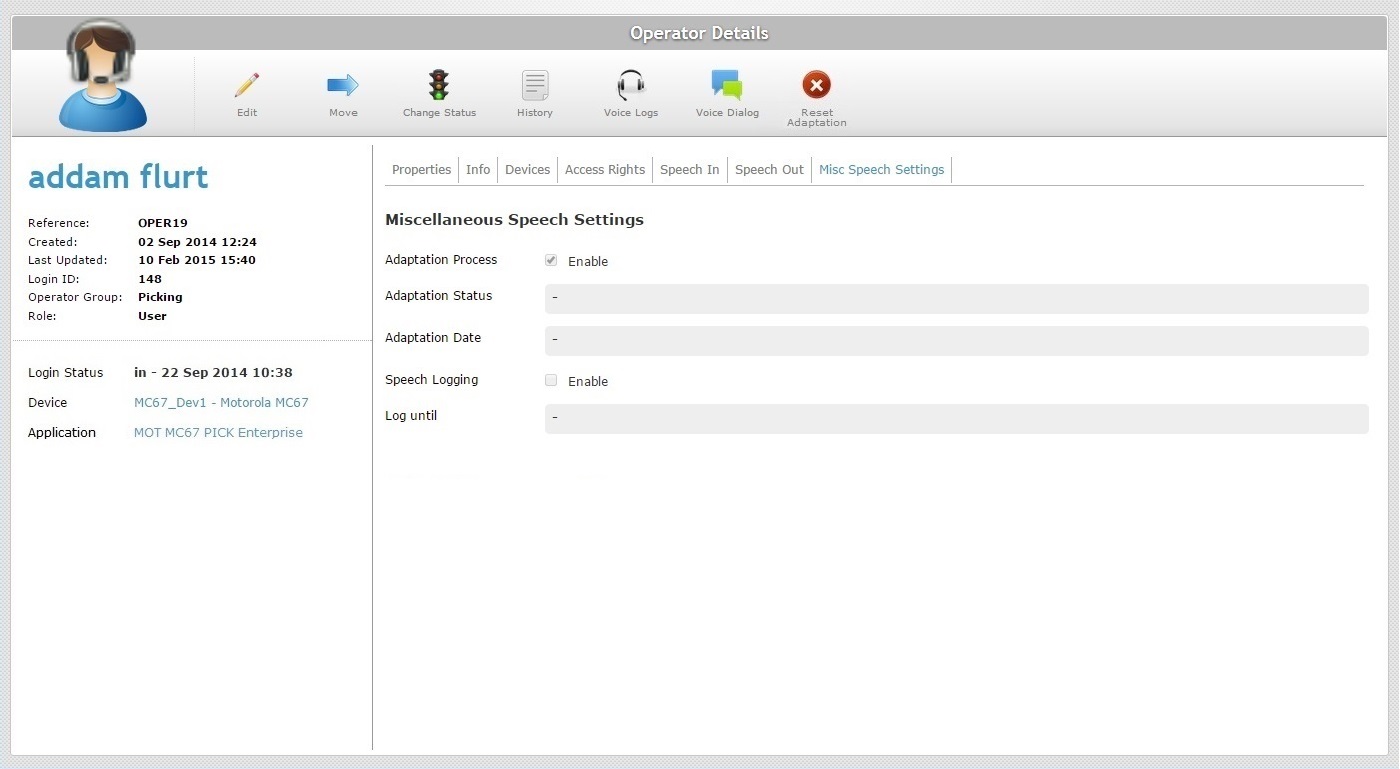
This tab, which is only available for speech operators, displays the following information:
Adaptation Process |
This option does NOT apply to operators running MCL-Voice V4 applications. For operators handling MCL-Voice V3 applications, consider the following: If the option is checked, the operator will use adaptation. If the option is unchecked, the operator will NOT perform an adaptation. Although adaptation is not considered a comfort setting, it has the same purpose - to take the operator's unique speech traits into consideration so that the speech recognition performance improves. See Adaptation.
The speech profile you associate to an operator group can have an enabled/disabled adaptation and this may or may not affect the operator’s adaptation related options. Operator profiles that have been created after having assigned a speech profile to their operator group, inherit the speech profile’s adaptation choice. Operator profiles that predate the speech profile’s assignation to the operator group are not affected by it. The previous adaptation decision overrides the one from the speech profile. |
Adaptation Status |
This option does NOT apply to operators running MCL-Voice V4 applications. For operators handling MCL-Voice V3 applications, consider the following: "Done" refers to the speech profile adaptation performed by the operator. If there is no adaptation, the field is blank. See Adaptation. |
Adaptation Date |
This option does NOT apply to operators running MCL-Voice V4 applications. For operators handling MCL-Voice V3 applications, consider the following: Refers the date of the most recent adaptation process performed by the operator. See Adaptation. |
Speech Logging |
If this option is checked, logs concerning speech dialog will be generated by the device every time the operator logs in. After logout, those logs are sent to the MCL-Mobility Platform account. If the option is not checked, the operator's speech performance will not generate logs. |
Log until |
When the logs stop being generated. |
![]()
If the operator is associated to a "custom" speech profile, additional speech related options are visible. This is due to the fact that there are no inherited speech parameters, all the settings were created in the operator's profile. A "custom" speech profile is an exception to be used in specific cases because the profile is designed to only suit the operator it is created for.
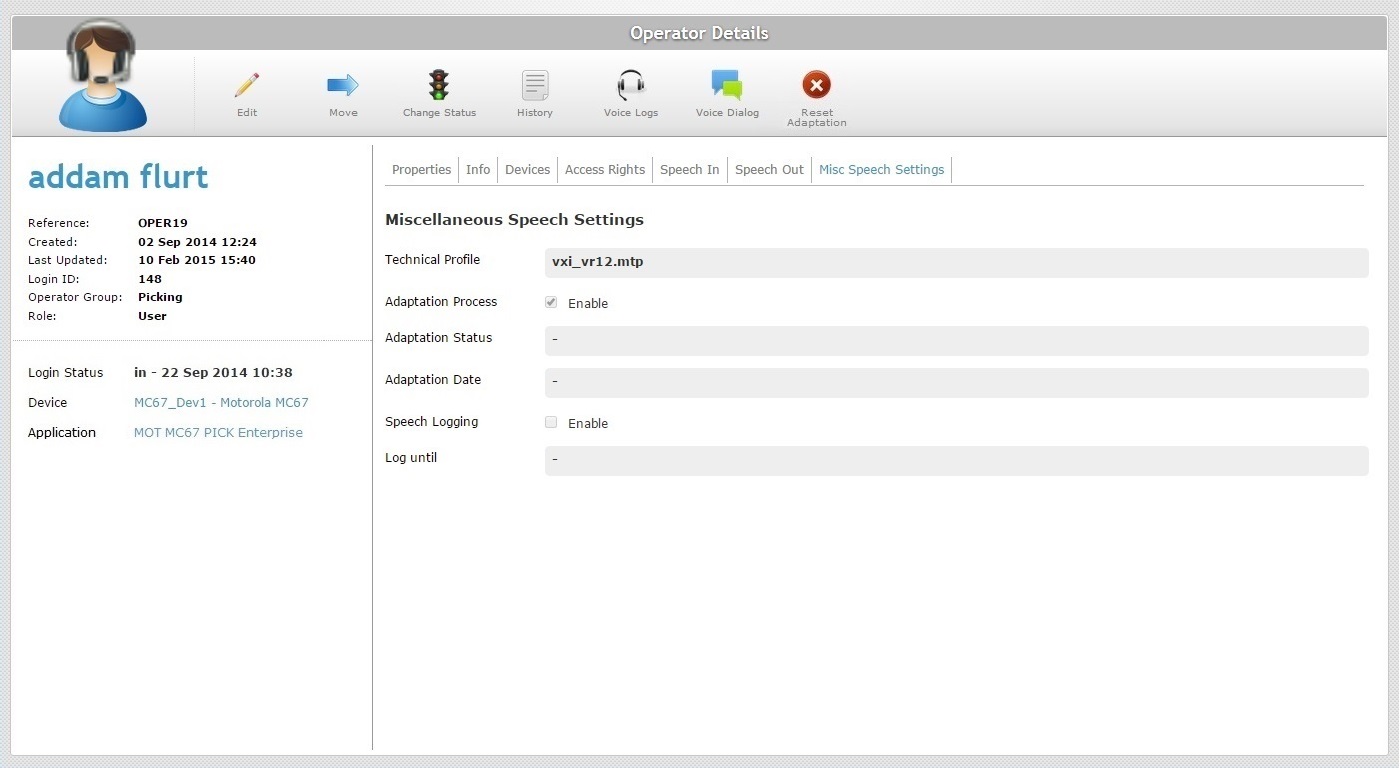
This is the additional option. Check the table above for information on the other options (adaptation and log related options).
Technical Profile |
The Technical Profile ( a configuration file, provided by MCL, that allows for the fine tuning of the MCL-Client behavior) that is associated to the operator's "custom" speech profile. |
"Left Panel"
The left side of the page also displays information:
|
Operator Icon |
|
(in blue) |
The operator's name (first and last). |
|
Reference |
The MCL-Mobility Platform's internal reference for the operator. |
|
Created |
When the operator profile was created. |
|
Last Updated |
When the operator profile was last updated. |
|
Login ID |
The operator's identification number in the account. |
|
Operator Group |
The operator group the operator is included in. |
|
Role |
The operator's role within the application. |
|
Login Status |
Informs if the operator is logged in or out of the system and when the operator has logged in. Possible login statuses: "in + date", "out"; "Never logged". |
|
Device |
The device being used by the operator. If you click it, you access the corresponding "Device Details" page. See Device Details. |
|
Application |
The application the operator has logged in. If you click it, you access the corresponding "Application Details" page. See Application Details. |
If you want to edit the details of an operator, click ![]() to set the corresponding "Operator Details" page to "edit mode". For more detailed information, see Editing Operator Details.
to set the corresponding "Operator Details" page to "edit mode". For more detailed information, see Editing Operator Details.
Available Operations
The "Operator Details" page also provides access to certain operations regarding operators:
To move an operator profile to another operator group, use ![]() . For more detailed information, see Moving an Operator.
. For more detailed information, see Moving an Operator.
To change the operator's status, use ![]() . For more detailed information, see To Change an Operator Profile's Status.
. For more detailed information, see To Change an Operator Profile's Status.
To view the operator's login history, click![]() to open the corresponding "Operator History" window. For more detailed information, see Detail of Operator History window below.
to open the corresponding "Operator History" window. For more detailed information, see Detail of Operator History window below.
Detail of Operator History window
This window presents the operator's login and log out history.

Operator History navigation
You can control the information that is displayed. To do so, use the following:
![]() You can filter the information available by focusing on a specific period of time. By default, the displayed information regards the current day. To establish a different time frame for the displayed information, you can enter the date(s) in the corresponding box (DD/MM/YYYY), use the arrows or select the date(s) with the use of the calendar:
You can filter the information available by focusing on a specific period of time. By default, the displayed information regards the current day. To establish a different time frame for the displayed information, you can enter the date(s) in the corresponding box (DD/MM/YYYY), use the arrows or select the date(s) with the use of the calendar:
1. Click the corresponding ![]() to open a calendar.
to open a calendar.
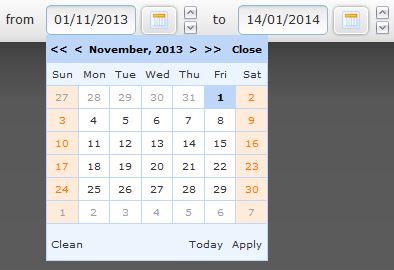
2. Select the appropriate date. Use the <</</>/>> to navigate the months/years.
If you want to clear any information, click ![]() .
.
If you want to select the current date, click ![]() .
.
If you want to exit the calendar, click ![]() .
.
3. Click ![]() and the information is viewed on the corresponding box.
and the information is viewed on the corresponding box.
![]() Use these buttons to control the amount of listed items displayed per page. Click the appropriate button.
Use these buttons to control the amount of listed items displayed per page. Click the appropriate button.
![]() Use the search box to filter the information:
Use the search box to filter the information:
a. Enter what you want to search for.
b. Click ![]() or press <ENTER> in your PC keyboard to initiate the search.
or press <ENTER> in your PC keyboard to initiate the search.
c. To conclude the search operation, empty the search box and click ![]() or press <ENTER> in your PC keyboard.
or press <ENTER> in your PC keyboard.
![]() These navigation buttons are only active, if the listed items are spread over more than one page. Use these buttons to navigate between pages.
These navigation buttons are only active, if the listed items are spread over more than one page. Use these buttons to navigate between pages.
Click ![]() to exit the window and return to the "Operator Details" page.
to exit the window and return to the "Operator Details" page.
Available operations in Operator History window
![]() Click this button to refresh the displayed information.
Click this button to refresh the displayed information.
![]() Click this button to download the information included in the "Operator History" window.
Click this button to download the information included in the "Operator History" window.
The conclusion of this operation depends on the web browser used. You should be able to save the file in your local computer or open it directly after the download.
To view the operator's Voice Logs, click![]() to open the corresponding "Voice Logs" window. For more detailed information, see Detail of Voice Logs window below.
to open the corresponding "Voice Logs" window. For more detailed information, see Detail of Voice Logs window below.
Detail of Voice Logs window

Use this operation to view the Voice Logs that are generated during the operator's speech application sessions.
Voice Logs navigation
You can control the information that is displayed. To do so, use the following:
![]() Use the search box to filter the information:
Use the search box to filter the information:
a. Enter what you want to search for ("Filename" and/or "Device Name" information).
b. Click ![]() or press <ENTER> in your PC keyboard to initiate the search.
or press <ENTER> in your PC keyboard to initiate the search.
c. To conclude the search operation, empty the search box and click ![]() or press <ENTER> in your PC keyboard.
or press <ENTER> in your PC keyboard.
Available operations in Voice Logs window
![]() Click this button to download the selected voice log file(s) included in the "Voice Logs" window.
Click this button to download the selected voice log file(s) included in the "Voice Logs" window.
Click ![]() to exit the window and return to the "Operator Details" page.
to exit the window and return to the "Operator Details" page.
To view the operator's Voice Dialog, click ![]() to open the corresponding "Voice Dialog" window. For more detailed information, see Detail of Voice Dialog window below.
to open the corresponding "Voice Dialog" window. For more detailed information, see Detail of Voice Dialog window below.
Detail of Voice Dialog window
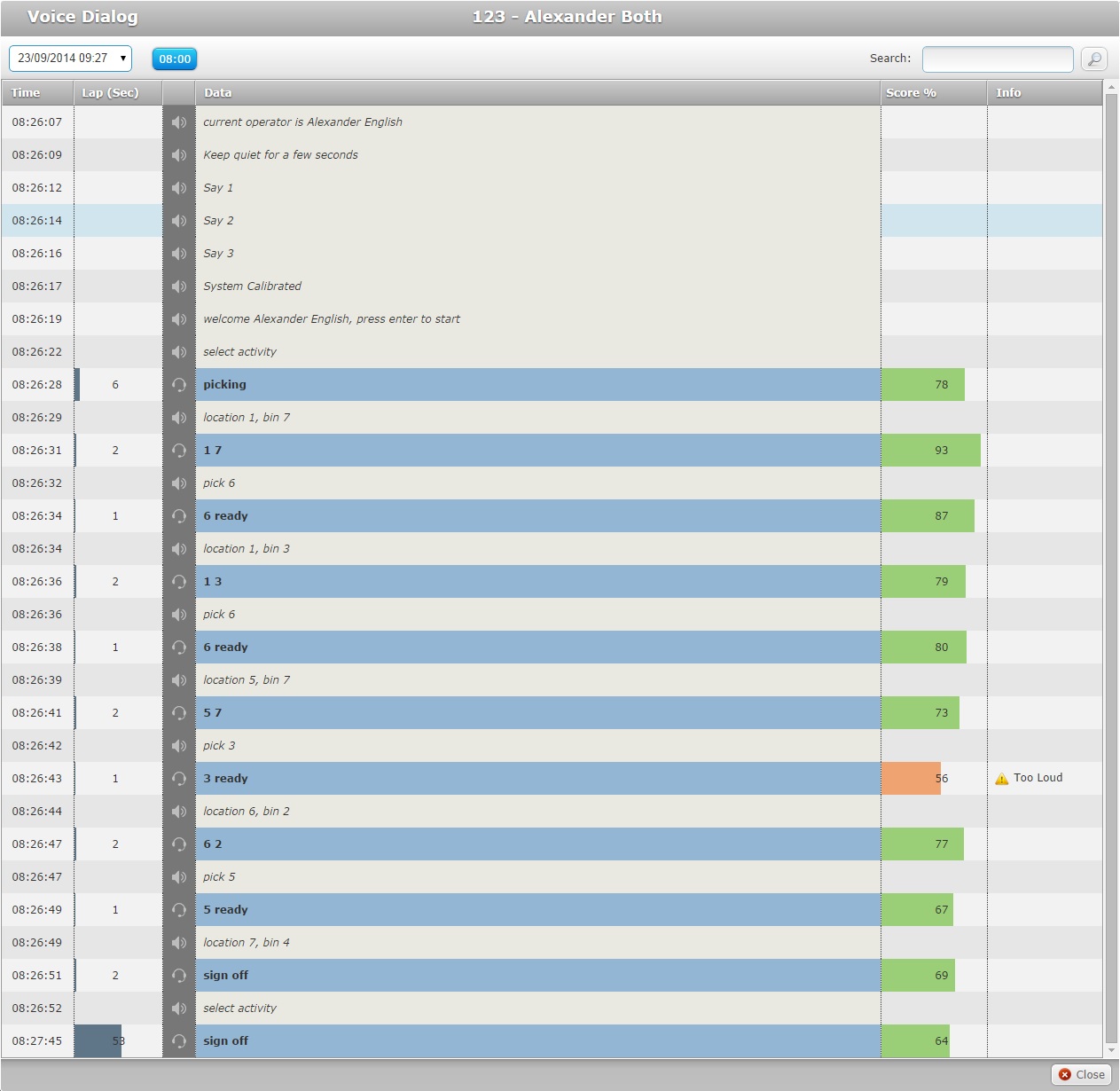
The Voice Dialog window displays information regarding the interface between speech operator and speech application.
Operator |
The operator's name and operator ID. |
Time |
When each interaction occurred. |
Lap (Sec) |
The time elapsed between each response. |
Data |
The actual words of the interaction. The icons to the left of each interaction identify the speaker:
|
Score % |
The percentage refers to a recognition score based on the speech engine's statistical calculations. |
Info |
Information regarding an operator's response with a difficult or failed level of speech recognition. |
Voice Dialog navigation
You can control the information that is displayed. To do so, use the following:
![]() Use this drop-down (located on the window's top left corner) to select a specific session by date/time. It includes the existing voice dialog sessions.
Use this drop-down (located on the window's top left corner) to select a specific session by date/time. It includes the existing voice dialog sessions.
![]() Use this button to view the application/operator interactions that occurred during the time frame indicated in the button. Each button represents one hour.
Use this button to view the application/operator interactions that occurred during the time frame indicated in the button. Each button represents one hour.
Ex: If the ![]() button is clicked, it will display all the interactions that occurred from 08:00 to 8:59.
button is clicked, it will display all the interactions that occurred from 08:00 to 8:59.
![]() Use the search box to filter the information:
Use the search box to filter the information:
a. Enter what you want to search for ("Filename" and/or "Device Name" information).
b. Click ![]() or press <ENTER> in your PC keyboard to initiate the search.
or press <ENTER> in your PC keyboard to initiate the search.
c. To conclude the search operation, empty the search box and click ![]() or press <ENTER> in your PC keyboard.
or press <ENTER> in your PC keyboard.
Click ![]() to exit the window and return to the "Operator Details" page.
to exit the window and return to the "Operator Details" page.
To reset an adaptation, use ![]() . This button is only active/visible under the following conditions:
. This button is only active/visible under the following conditions:
•The operator must have performed an adaptation (while running MCL-Voice V3 applications). For more detailed information, see Adaptation.
•The operator must be logged off.
•The site user accessing the operator's "Operator Details" page must have the appropriate access rights, meaning, "Advanced Access Rights" (see Site User Details Access Rights).
•The "Operator Details" page cannot be in "edit mode", it must be in "view mode".
![]() The reset of the adaptation data only affects operators handling MCL-Voice V3 applications.
The reset of the adaptation data only affects operators handling MCL-Voice V3 applications.
Step-by-step
1. Open the selected operator's "Operator Details" page (the operator must NOT be logged in).
2. Click ![]() .
.

3. Click ![]() to conclude the operation.
to conclude the operation.
At this point, the ![]() button disappears from the header of the "Operator Details" page and the corresponding information in the "Misc Speech Settings" tab ("Adaptation Status" and Adaptation Date" fields) disappears.
button disappears from the header of the "Operator Details" page and the corresponding information in the "Misc Speech Settings" tab ("Adaptation Status" and Adaptation Date" fields) disappears.
When the operator logs in again, he will be asked to execute a new adaptation.